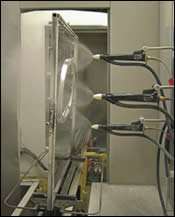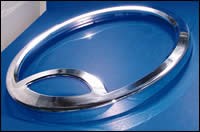The Illusion of Chrome
Company expands its powder-on-plastic technology offerings to include chrome replacement
For some years, many in industry have desired and searched for a technology to replace hexavalent chromium plating. This desire has been driven primarily by the environmental concerns with traditional electroplating.
The European Community’s RoHS Directive, which took effect July 1, 2006 for all European manufacturing and imports to Europe, outlines “the restriction of the use of certain hazardous substances in electrical and electronic equipment.” This directive effectively bans new electrical and electronic equipment containing more than agreed levels of lead, cadmium, mercury, hexavalent chromium, polybrominated biphenyl (PBB) and polybrominated diphenyl ether (PBDE) flame retardants.
Featured Content
At home, exporters to Europe must abide by the RoHS directive. In a perfect world, harmony of production for both Europe and North America would be desirable. In the U.S., the EPA’s stringent new environmental guidelines regarding traditional electroplating operations, with California leading the charge, will put even more strain on an already taxed industry.
This is not even to mention worker safety issues. The U.S. Occupational Safety and Health Administration (OSHA) recently implemented new permissible exposure limits (PELs) for hexavalent chromium that will place an additional burden on chrome plating operation.
All these new regulations will require significant capital expenditures for most of the existing industry electroplating participants, and may even force the closure of many facilities not able to meet these new guidelines. The repercussions will be a dwindling of capacity and an associated increase in pricing.
The problem, of course, is that hexavalent chromium works. It works well. And given hex chrome’s range of application—from decorative and functional electroplating to chromate post-treatments and others—it should be obvious that there’s not going to be a single replacement for hex chrome.
Our company is a world leader in the powder coating of plastic and other nonconductive substrates. (See the article “Plastic Man” in the January 2005 issue of Products Finishing www.pfonline.com/articles/010501.html.) We currently powder coat millions of plastic components per month for some of the largest players in various industries, from appliances to office furniture. Our offerings include metallic, solid, texture and clear-coat applications on a variety of non-conductive substrates, nylon (polyamide) being the predominant substrate of choice.
Nearly two years ago, we launched an initiative to develop a chrome replacement technology (CRT) for plastics and other non-conductive substrates utilizing our current powder on plastics technology. Based on the RoHS directive and the challenges this directive would place on our customers, we felt development of such a technology would be extremely desirable to our customers.
Working with several key customers, we successfully developed the CRT technology at our research and development center in Toronto, ON, and we are gearing up for a commercial launch of the technology as this is written.
Background
The current substrate of choice within the resin world for traditional electroplating is that of PCABS. Nylon and nylon blended materials have been precluded from traditional electroplating in North America due to the inability of plated coatings to achieve the required adhesion characteristics and other issues. Nylon is a desirable material to have electroplated, but involves a very complicated and costly pretreatment that is currently only available in Europe on a limited basis. With the implementation of the RoHS directive, it is understood that any further development of this technology in North America has been shelved.
The search for an alternative technology was on well before we launched our own initiative—research by various coaters and material suppliers into the replacement of electroplating has been ongoing for some years. Vacuum metallizing, for example, has been used for more than a decade, with a familiar application being automotive headlight lenses. Vacuum metallizing lends itself to this application because it is shielded or protected by a clear lens cover.
Typically, vacuum metallizing is a two-stage process in which a metallic layer (usually aluminum or aluminum alloy) is deposited onto the plastic substrate, then top-coated with a clear liquid for moisture and oxidization protection. The resulting coating provides a chrome-like, highly reflective surface. The issue with this deposition and liquid clear coat is that it is unable to offer a durable surface finish outside of the protection of the lens covering.
Other alternatives being evaluated are materials like silver nitrates with protective liquid clear coatings. Inherent in this process are cost issues with the raw material and processing difficulties surrounding silver nitrate-based liquid applications. The silver nitrate still requires a clear top coat to protect the substrate from oxidation, which happens immediately after coating. This can lead to processing issues, in which there is a very narrow window to provide the protective clear coat. In addition, the issue of performance capable of meeting automotive specifications is still questionable at this time.
Although these alternatives offer aesthetics in keeping with traditional electroplating, the issue has been their inability to meet exterior automotive as well as other industry specifications. There is no doubt that a powder solution as a CRT is the desired option. The performance characteristics of powder are widely known, and in most cases either meet or exceed any durability and performance characteristics of liquid coatings.
Technology Overview
With the advent of ultra-durable powders and the years of automotive data, it was a logical fit for our company to use its current knowledge base to extend powder coating of plastics to CRTs. Combining the superior performance characteristics of polyamide and polyamide blended materials over conventional PC/ABS resins and an environmentally friendly, powder-based CRT that meets industry aesthetic and performance criteria translates into an enormous market potential for this technology.
Our company has worked closely with BASF, a Strategic Partner, to commercialize this technology for polyamide parts. BASF is currently the largest supplier of polyamides worldwide, and looks to this partnership to further promote the capabilities of polyamides as a desirable and preferred substrate for painting and CRT.
Auto and Appliance
As part of the arrangement, both companies have been developing commercial applications, conducting trials and testing of suitable resin and powder technologies. We plan to launch commercial application of the CRT technology in two key industries, automotive and appliance.
In the automotive industry, the base technology used to meet stringent automotive specifications is that of approved powder coating technologies currently in use on metal substrates. We combine thin-film anti-chip primers and clear-coat technologies with our proprietary CRT technology.
Automotive OEMs and their suppliers look to utilize this technology in many applications, but none are more important than door handles. In many instances the requirement is to provide an exterior door handle with polyamide performance in an electroplated finish.
Because there are no commercial sources in North America for traditional electroplating of nylon, OEMs are left with three alternatives. The available options are mold in color, typically black; ASF powder coating using metallics, solids or textures; and liquid paint, again using solids and metallics.
Unfortunately, none of these alternatives provides the desired finish. Our new technology gives automotive designers the opportunity to specify a chrome-like finish coupled with the performance of characteristics of a polyamide substrate at a competitive price. Of course, automotive applications for this technology do not end with door handles—roof racks, mirrors and other exterior accent components are also candidates.
The appliance industry will also use CRT in a variety of applications, from handles to washer/dryer rings and bezels. Again, the performance of a nylon substrate with the look of chrome is critical to meet not only durability testing and appearance specifications but also RoHS compliance guidelines. Typically, multinational manufacturers are looking for finishing options that are applicable across all product lines and all markets while meeting global environmental concerns. Our powder process helps appliance designers achieve this goal.
Appliance manufacturers currently rely mainly on powder painting of metal substrates as their finishing method of choice. The industry has embraced this technology as well as ASF’s powder-on-plastic technology, so it should be no surprise that they have similarly endorsed our company’s CRT technology. Appliance manufacturers in particular are already our major customers in the application of powder to plastics, and with the proven success of metallics solids and texture paints have equally endorsed the CRT technology.
The basis for CRT in the appliance industry applications is application of automotive-approved powder technology. ASF utilizes automotive thin-film anti-chip primers to provide a non-peeling surface for the intermediate and topcoat layers. The primer allows leveling of inconsistent surfaces while helping to hide molding parting lines. The process is finalized with an automotive-approved high-, medium- or low-gloss clear coat. Unlike traditional electroplating, in which the immersion tank dictates the color, ASF offers an unlimited palette of tints that can replicate bright chrome, stainless steel or anodized and dyed colors such as reds and greens.
Benefits of CRT on Plastic
Regardless of the final application, CRT on plastic substrates can have multiple benefits. These include:
- Environmentally friendly—meets RoHS requirements
- Cost-effective
- Ability to provide a chrome-like finish on polyamide materials
- Meets automotive specifications
- Ability to reduce visible mold parting lines
- Unlimited palette of color tints
- Stainless steel effect without secondary operations.
And the technology is not just for nylons and nylon blend materials, either. Other available plastics materials for CRT application include polybutylene terephthalate (PBT), high-temperature polycarbonate, high-temperature reaction-injection molded (RIM) materials, sheet molding compounds (SMCs), and bulk molding compounds (BMCs).




















